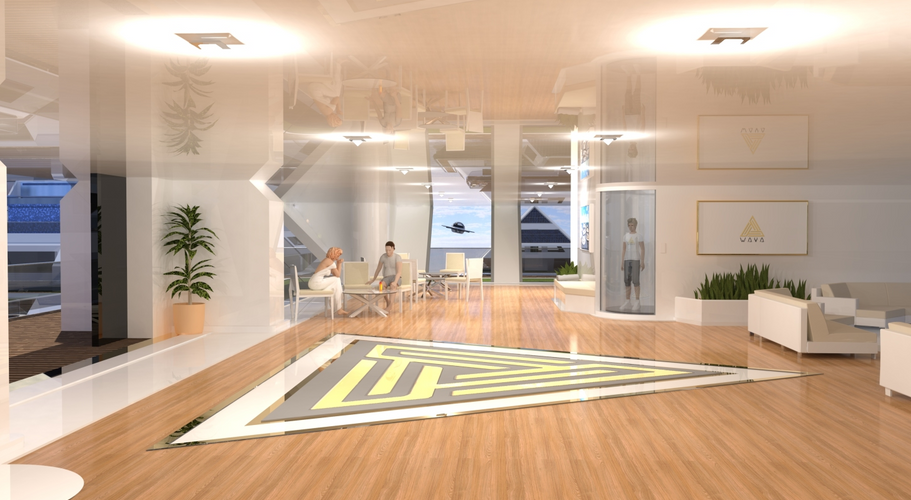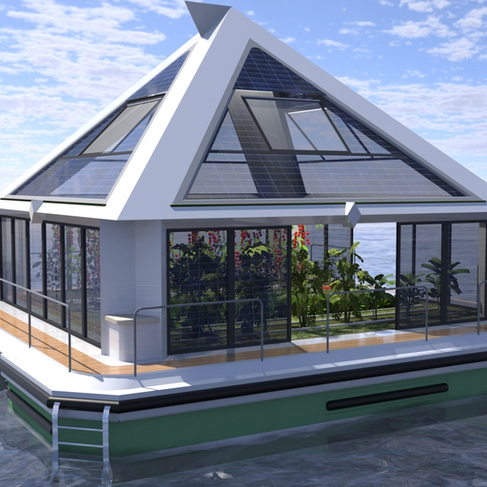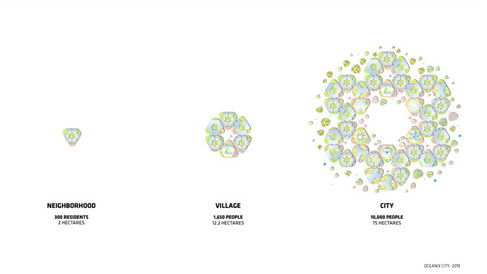Seaphia’s Winter Curated Floating Projects
- Nataly Velásquez Rodríguez
- Jan 7, 2022
- 9 min read
Updated: Mar 14, 2022
Writer: Nataly Velásquez Rodríguez. Editor: Nathalie Mezza-García.
@SeaphiaGroup
Hard to believe but it’s true, we’re already in the third year of the decade, and 2022 is actually the target date for some of the most ambitious enterprises in Aquatecture (or architecture on/related to water) across different latitudes, for which we have chosen our top 5 + Surprise bonus Floating City Projects to star in Seaphia’s winter selection!
From inspiration in pre-colonial building styles to tangible dreams of new free nations, we will share the answers to What, Where, Who, When, and Why are designers, architects, developers, governments, and seasteaders investing time, money, and energy in creating the cities of the future, that will have the beautiful and still fully unveiled Sealife as their closest neighbors.
1. Maldives Floating City By Dutch Docklands & Waterstudio.

Coral reefs have helped protect the Maldives from devastating tsunamis. The most recent was in 2004 after the Sumatra–Andaman earthquake. Rooted in the deep respect for coral that the Maldives population holds at heart, and in coalition with the local government, companies from The Netherlands celebrated the official launch of the Maldives Floating City on March 14, 2021. The shape of Brain Coral was the baseline for the organization of the planned city that would be located on a lagoon of more than 200 ha near the capital, Malé.

Consisting of 99.6% water, the Maldives spreads on tiny islands that are seriously threatened by rising sea levels. The reason behind the development is the urgency of affordable, safe, and sustainable housing that may withstand the forces of nature and time.

Ex-President Mohamed Nasheed has been at the center of the Floating City work. As one of the founding members of the Maldives Coral Institute, Nasheed speaks proudly of how the buildings will promote the regeneration and growth of new coral banks by placing artificial reefs under the floating structures, so both implanted and natural coral act as wave breakers.

An interesting concept used by the creators of the project is Sustainaquality: “the search for new ways to increase sustainability by using water. From sustainability to sustainaquality”. The image below is a solar blanket field, Intellectual Property of the developer companies.


In order to make dwellings economically accessible to Maldivians, the authorities will provide financial alternatives to potential owners, including mortgages. This is a revolutionary idea for many parts of the world, where it is not possible to get property loans for floating homes. That said, foreign demand is encouraged as well. The Maldives Floating city offers residence permits to international buyers. The tropical and breezy climate all year round plus the incommensurable biodiversity of the region, increase the likelihood of success in sales that are projected to start this year, followed by construction.
2. WAYALAND by Lazzarini Design Studio.

“Think about the future, never forget the past . . .” it’s not explicit but it must have been
Pierpaolo Lazzarini who felt this phrase would encompass his art direction and purpose. Lazzarini is well known in some continents for its stylish and unique automotive, aerospace and yacht designs. A few years ago, the studio presented their vision of an offshore city, where living and working spaces are Wayas—modern pyramids that take on the ancient Mayan architecture and turn it into a luxury and multifunctional marvel.

Wayas vary in size. “The Suite” sits on a 10m x 10m platform. It has 2 floors and an area of 160 sq m. The Waya Palace has 10 stories that start ascending from the 3000 sqm base. It features a valet area for equally cutting-edge personal boats, hotels, gyms, and entertainment.
Mr. Lazzarini also found inspiration in Japanese Temples. Their roofs are four-sided, thus providing considerable space for solar panels. Wide windows let natural light in. The project aims at being a self-sustainable community: all the Wayas are designed with water turbines underneath that generate additional power. Close to them, there is a submerged room to extend usable areas. Wayas would be made of fiberglass, carbon fiber, and steel, and would be able to move at a slow pace through short distances.

The food will grow in floating gardens.
As all of the Floating City Projects in our curated list, WAYALAND invites the public to get interest and involvement in the endeavors, via crowdfunding in this case. € 1 gives contributors their name on the contributors' web list and € 1000 books contributors to one night in the Waya Suite. Lazzarini hopes to have the Wayas up and running at the end of 2022. Contributions come with voting rights on the location of the first Waya module. Suggested places are the Tyrrhenian Sea in Italy, the Caribbean Sea, South China Sea, the Persian Gulf, and the Mexican Gulf.
3. OXAGON by NEOM.

Imagined and promised to host the first Next-gen automated & integrated port & supply chain in the world, Oxagon will be a cognitive, industrial city in the Northwest of Saudi Arabia. It is part of NEOM, the Kingdom’s newest urban development. Half of the city will be floating on the Red Sea. It will span over 7 km, and it is likely to become the largest floating structure at its construction.

The focus will be placed on fostering research and business ecosystems, enabled by state-of-the-art robotics, AI, Machine Learning. These technologies will showcase the feasibility of combining hectic manufacturing centers with a healthy community style. There will only be canals and walk sides for transportation, no cars will be allowed and the city itself will be powered by 100% clean sources of power. Oxagon will become key to commerce in the region, since close to 15% of the world’s trade goes through the Suez Canal close to which the city will be strategically located.

To attract resident companies and people, investors, and tourists, Oxagon facilities are designed to offer exceptional living conditions. Additionally, it will be comfortably reachable by plane in 4 hours from almost half of the planet.
With such a magnitude of a plan, not only entrepreneurs are being chased by NEOM’s team, a huge workforce is required to bring the vision to life, so there is even a dedicated page to career opportunities that will for sure blossom in the unstoppable Persian Gulf.

4. Oceanix by BIG-BJARKE INGELS GROUP.

You may have heard of this project already, as it gained global popularity once UN-Habitat backed the realization of a floating city that intends to solve the housing crisis affecting millions worldwide. When completed Oceanix will have 10.000 inhabitants on an estimated 75 ha, that will harmoniously coexist with instead of disrupting, undersea living creatures and dynamics. Marc Collins Chen, one of the founders, was part of the team trying to create a floating community in French Polynesia sustained by cryptocurrencies. Collins co-founded Ocenix while there were conversations in French Polynesia to create the Floating Island. The work of his wife Itai Madamombe, who has held several positions at the UN, was essential to present the project at UN-Habitat.

Biorocks will fix Oceanix’ structures to the seabed. The solar panels on the top of edifices, made of bamboo or other materials with low to negative carbon footprint, and their design that fans out to provide shade and natural cooling are in accordance with the foreseen organic growth of the city, from modular neighborhoods of about 2 ha and 300 people to villages (6 neighborhoods) and the whole city that comprises 6 villages total. Communal farming and zero-waste are principles that will guide the self-sufficiency of each component of the place.

17 companies and organizations form the Oceanix City partners list. It includes a diverse group of marine experts (ARUP, Center for Oceanic Engineering and Global Coral Reef Alliance, to name a few), architects (Studio Other Spaces), innovators in climate and environment technology (Agritecture, Transsolar Klima Engineering), and academics (Korea Maritime and Ocean University). Reports indicate the Metropolitan city of Busan in South Korea accepted Oceanix conducted a feasibility study for a large-scale floating project that would begin construction sometime this year off the coast of the Asian country.
5. Free International Communities projects at sea with the support of The Seasteading Institute.
If you were lucky to enjoy some time off during the holidays, you might have stumbled upon the 2020 Netflix Movie “Rose Island”, a fiction inspired by the real story of architect Giorgio Rosa in Italy back at the end of the ’60s. Pursuing Freedom, Rosa built a platform beyond the Exclusive Economic Zone of his country and named it Isola Delle Rose. He wanted it to be a micro-independent nation. The sitting Italian government at the time quickly destroyed his ambition and Giorgio saw the platform being demolished on February 11, 1969.

The vehement drive to escape the current status quo in modern democracies, and to free oneself from a top-down, higher level, established regulator is embodied nowadays by several groups all over the world. Seasteaders are one of them, proposing experiments with new forms of society at sea, many with a symbiotic relationship between humans and sea life. Their ultimate quest is the implementation of alternative governance approaches and improved human interactions without imposed rules or precepts other than voluntary ones. The Seasteading Institute has served since 2008 as the leading think tank for the flourishing of these ideas and undertakings. We invite you to check The Eight Great Moral Imperatives that guide their actions, also to read their relevant research papers on topics such as Flagging options for seasteads—politically autonomous communities on international waters.

Without further ado, here are the Floating Cities projects on international waters that made it to our list:
Freedom Haven led by Tony Olsen, USA.
This project is a libertarian seastead. Quoting their website “Freedom Haven will be a place where people who seek freedom can live in peace. By Freedom, we mean (at a very high level)": without government coercion. The city plan is supported by individuals of any nationality, using their names or anonymously, the advance and activities are coordinated in meetings in person and online. Facebook groups are vital for the dialogue and promotion of the development.

The design is a vessel-like structure called “New Liberty” and it gets updated - enriched with the contributions of supporters. A formal document has been written as The Constitution of the Provinces of Freedom Haven and the goal is to offer the most affordable seasteading alternative with the highest level of freedom: “10-years of open-sea-safe living space for $444/square-foot, $4,784/square meter, or $65,005/TEU”. It could be manufactured by Samsung Heavy Industries in South Korea and would be moved later to the Bay of Bengal.
Ocean Freedom by Eduardo Terra Estudio de Arquitectura, Brazil.
It’s an initiative to found a free and private community where residents are able to organize themselves, interact and live according to their own principles, desires, and convictions. The general respect of everyone’s natural rights in the search for happiness and the conquest of authority rather than its imposition, are also core to Ocean Freedom.

Site visitors are welcome to express their thoughts and willingness to join the project through a fill-out form, that doesn’t create obligations but serves the creators as a database to understand the needs that will have to be catered to when creating the city.

The location of the free nation would be Vitória-Trindade Seamount Chain, a series of small volcanic islands in front of the states of Espiritu Santo and Rio de Janeiro in Brazil on the South Atlantic Ocean. The distance of Davis Bank from both Islands (Vitória & Trindade) is more than 200 nautical miles, therefore it is not within Brazilian Jurisdiction. Transport times and alternatives are considered to be reasonable as Ocean Freedom will be reachable from 4 of the main ports in the country by air or water.
Surprise bonus: Seaphia’s Floating City - Colombia
It is exciting to share with you for the very first time, our initial design of a floating community in the North Coast of Colombia, the country of origin of our CEO and some team members!

Resembling fractals and the H2O Molecule, Seaphia’s city on water will be a point of reference for blue and green sustainable systems in place for production, waste management, and maintenance. The structures will be made of locally sourced natural materials to the extent possible, the available wind and ocean currents will generate energy, floating solar panels will complement the landscape, and innovation hubs will be the economic engines of the pioneering urban creation.

For centuries, indigenous communities in South and Central America have developed ways to live with water. However, in some cases, their forced inclusion in the industrial era has taken from them the ability to evolve and continue this tradition. Nowadays, hundreds of thousands of Colombians suffer floods every year that wash out the handmade houses and few possessions of very vulnerable populations.
Seaphia wants to step up and offer a viable solution through the marvels of aquatecture: luxury floating homes may be sold to clients who can afford the latest trends on design and technology, and part of the profit may be used to fund projects with multiple stakeholders that benefit people at risk on the riversides and long coasts of the country.
Watch the video!
We hope you’re floating with these breathtaking city plans, remember to click on the hyperlinks to get more information on the projects and participate in their progress. Thanks for living the journey and stay tuned for the Spring Curated Floating Projects Selection by Seaphia, it’s getting even better!
Enjoy the Vlog!





















Comments